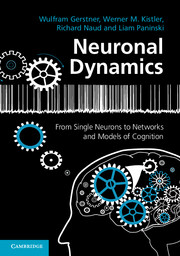Book contents
- Frontmatter
- Contents
- Preface
- PART ONE FOUNDATIONS OF NEURONAL DYNAMICS
- PART TWO GENERALIZED INTEGRATE-AND-FIRE NEURONS
- 5 Nonlinear integrate-and-fire models
- 6 Adaptation and firing patterns
- 7 Variability of spike trains and neural codes
- 8 Noisy input models: barrage of spike arrivals
- 9 Noisy output: escape rate and soft threshold
- 10 Estimating parameters of probabilistic neuron models
- 11 Encoding and decoding with stochastic neuron models
- PART THREE NETWORKS OF NEURONS AND POPULATION ACTIVITY
- PART FOUR DYNAMICS OF COGNITION
- References
- Index
11 - Encoding and decoding with stochastic neuron models
Published online by Cambridge University Press: 05 August 2014
- Frontmatter
- Contents
- Preface
- PART ONE FOUNDATIONS OF NEURONAL DYNAMICS
- PART TWO GENERALIZED INTEGRATE-AND-FIRE NEURONS
- 5 Nonlinear integrate-and-fire models
- 6 Adaptation and firing patterns
- 7 Variability of spike trains and neural codes
- 8 Noisy input models: barrage of spike arrivals
- 9 Noisy output: escape rate and soft threshold
- 10 Estimating parameters of probabilistic neuron models
- 11 Encoding and decoding with stochastic neuron models
- PART THREE NETWORKS OF NEURONS AND POPULATION ACTIVITY
- PART FOUR DYNAMICS OF COGNITION
- References
- Index
Summary
In the ten preceding chapters, we have come a long way: starting from the biophysical basis of neuronal dynamics we arrived at a description of neurons that we called generalized integrate-and-fire models. We have seen that neurons contain multiple types of ion channels embedded in a capacitive membrane (Chapter 2). We have seen how basic principles regulate the dynamics of electrical current and membrane potential in synapses, dendrites and axons (Chapter 3). We have seen that sodium and potassium ion channels form an excitable system characterized by a threshold mechanism (Chapter 4) and that other ion channels shape the spike after-effects (Chapter 6). Finally, we have seen in Chapters 4, 5 and 6 how biophysical models can be reduced by successive approximations to other, simpler, models such as the LIF, EIF, AdEx, and SRM. Moreover, we have added noise to our neuron models (Chapters 7 and 9). At this point, it is natural to step back and check whether our assumptions were too stringent, whether the biophysical assumptions were well-founded, and whether the generalized models can explain neuronal data.
We laid out the mathematical groundwork in Chapter 10; we can now set out to apply these statistical methods to real data. We can test the performance of these, and other, models by using them as predictive models of encoding.
- Type
- Chapter
- Information
- Neuronal DynamicsFrom Single Neurons to Networks and Models of Cognition, pp. 267 - 286Publisher: Cambridge University PressPrint publication year: 2014



